Media
HKU develops inhaled dry powder formulation of messenger RNA
Opens up new possibilities for treating and preventing various lung diseases
21 Nov 2019
A research team from the Department of Pharmacology and Pharmacy, LKS Faculty of Medicine, The University of Hong Kong (HKUMed), is the first one that reports on an inhalable dry powder mRNA formulation. This new technology opens up an exciting opportunity to use mRNA for treating and preventing various lung diseases. The research is published in Journal of Controlled Release (link to the publication), and is featured in the cover story. A provisional application has been filed to USPTO based on this work.
Background
Messenger RNA (mRNA) has a huge potential as therapeutics for the treatment of a variety of diseases. Instead of using protein as a drug, mRNA therapeutics works by instructing our body to generate specific proteins in order to produce a therapeutic effect. However, the most difficult barrier to overcome is delivery, which must be addressed before the mRNA therapeutics can be used in the clinic.
Our team has successfully developed a safe and effective inhaled formulation of mRNA with potential to be used to treat various lung diseases such as asthma, chronic obstructive pulmonary disease (COPD), cancer, or as inhaled vaccines to prevent respiratory infections such as influenza. Administration by inhalation can maximize local concentration in the lung, reduce systemic exposure and side effects, thereby enhancing efficacy of treatment. The most attractive feature of this mRNA formulation is the employment of particle engineering techniques to produce inhalable dry powder, which is far more stable and patient-friendly with a lower treatment cost as compared to liquid formulation administered by nebulization, which requires bulky device with long administration time (may take up to 30 minutes).
Design of formulation and research findings
mRNA is a fragile and unstable molecule that is susceptible to physical and enzymatic degradation. A transfection agent is therefore required to deliver the mRNA into the target cells, and to protect the mRNA from premature degradation. Inspired by pulmonary surfactant lining the airways, the team has developed a biocompatible PEGylated cationic peptide, PEG-KL4, which mimics the surfactant protein (SP-B), as mRNA transfection agent to facilitate cellular uptake of mRNA in the lung. Two particle engineering techniques, namely spray-drying and spray-freeze-drying, are used to formulate the peptide/mRNA complexes into dry powder form with excellent aerosol properties suitable for inhalation. Animal studies were performed to demonstrate that the target protein (luciferase) was successfully expressed in the lungs (and in the lungs only) for up to at least 24 hours after pulmonary administration of the formulation.
Significance of the study
The PEG-KL4/mRNA dry powder formulation is a breakthrough invention, and the HKUMed research team is the first to demonstrate good transfection efficiency of an inhalable mRNA powder formulation in animal models. Lung diseases such as severe asthma, COPD, respiratory infections and cancer are enormous global health and economic burden. This exciting new platform technology of mRNA delivery opens up a new opportunity to treat lung diseases where there is a substantial unmet medical need. In addition, the team now focuses on the use of this technology to develop an inhalable mRNA vaccine formulation. Compared to traditional live-attenuated or inactivated vaccines, inhaled mRNA vaccine can be self-administered, avoid cold-chain requirement, and have a much faster production rate in case of pandemic emergency.
About the research team
This research was led by Dr Jenny Lam, Associate Professor of the Department of Pharmacology and Pharmacy, HKUMed. Ms Carol Yingshan Qiu, PhD student of the Department, was the first author. Dr Michael Chow, former PhD student, now a postdoc in the University of Sydney, and PhD students Mr Rico Chi-Hang Man and Ms Rachel Qiuying Liao were co-authors and they also performed the experiments.
Acknowledgements
This work was supported by National Natural Science Foundation of China (NSFC) - General Program (No. 81573373), Health and Medical Research Fund (HMRF) (No. 15140962), and General Research Fund (GRF), Research Grant Council (RGC) (No. 17301918; 17300319) and Seed Fund for Basic Research of The University of Hong Kong (No. 201711159172).
Media enquiries
Please contact LKS Faculty of Medicine of The University of Hong Kong by email (medkefa@hku.hk).

